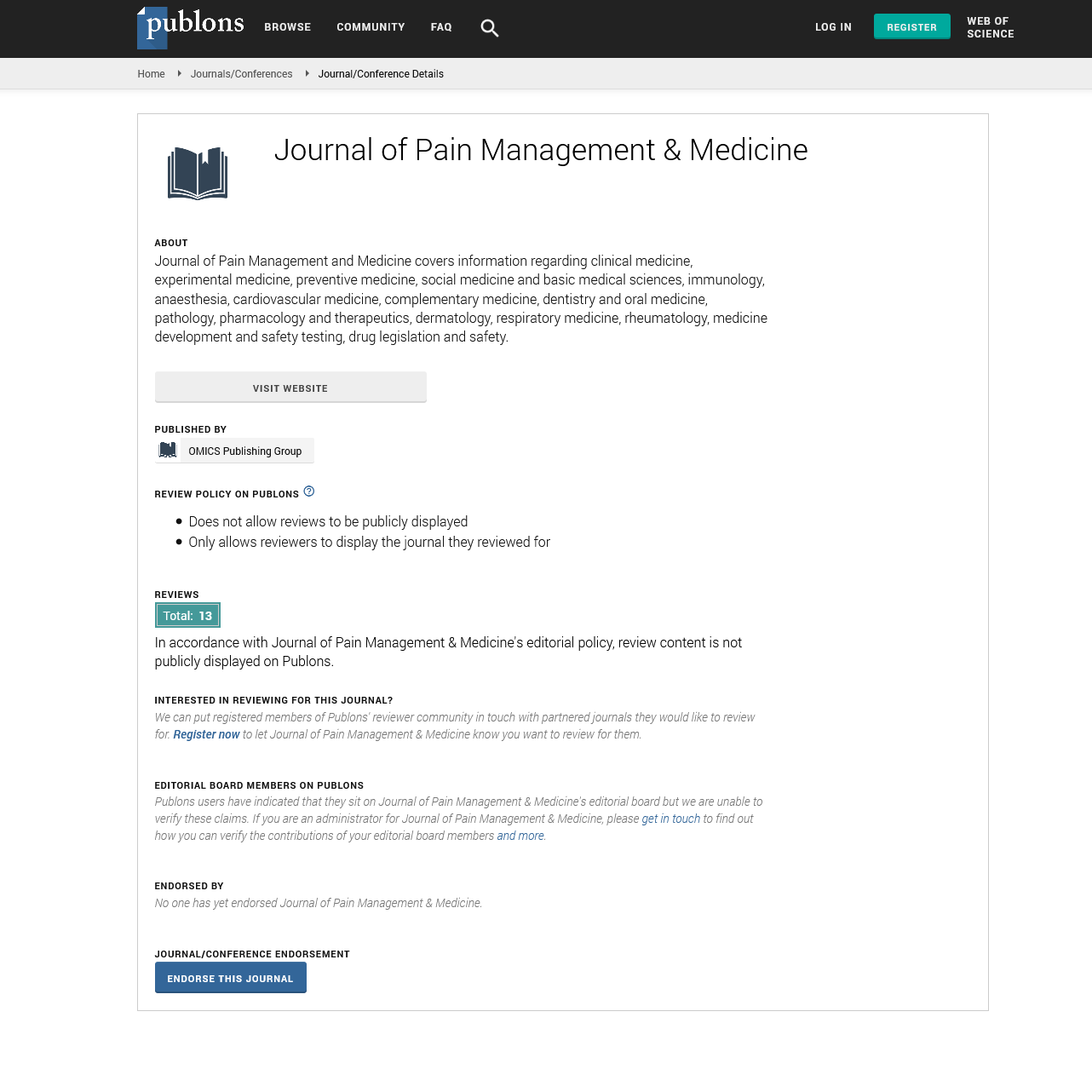Indexed In
- RefSeek
- Hamdard University
- EBSCO A-Z
- Publons
- Euro Pub
- Google Scholar
- Quality Open Access Market
Useful Links
Share This Page
Journal Flyer

Open Access Journals
- Agri and Aquaculture
- Biochemistry
- Bioinformatics & Systems Biology
- Business & Management
- Chemistry
- Clinical Sciences
- Engineering
- Food & Nutrition
- General Science
- Genetics & Molecular Biology
- Immunology & Microbiology
- Medical Sciences
- Neuroscience & Psychology
- Nursing & Health Care
- Pharmaceutical Sciences
Perspective - (2022) Volume 8, Issue 1
Effects of Pain on Body
Ikemoto Tufan*Received: 04-Jan-2022, Manuscript No. JPMME-22-112; Editor assigned: 06-Jan-2022, Pre QC No. JPMME-22-112 (PQ); Reviewed: 20-Jan-2022, QC No. JPMME-22-112; Revised: 24-Jan-2022, Manuscript No. JPMME-22-112 (R); Published: 31-Jan-2022, DOI: 10.35248/2684-1320.22.8.112
Description
Pain is a complex protective mechanism. It is an integral part of evolution that protects the body from danger and damage. The body has two major types of nerve-sensitive pain receptors that sense danger. The nervous type relays the message quickly, causing sharp and sudden pain. The other slowly relays the message, causing dull, throbbing pain. There are more pain receptors in some areas of the body than in others. For example, the skin has many receptors, so it is easy to pinpoint the exact location and type of pain. It is more difficult to pinpoint the exact location of abdominal pain because there are far fewer receptors in the intestine. When skin pain receptors are activated by touching dangerous objects (such as hot or sharp objects), these nerves send an alarm to the spinal cord and then to a part of the brain called the thalamus.
The spinal cord may immediately send a signal back to the muscle to contract. This keeps the affected body part away from the source of danger or harm. This is a reflex reaction that prevents further damage. It happens before you feel pain. When the “Alert!” Message reaches the thalamus, it classifies the information sent by the nerves based on past experience, beliefs, expectations, culture, and social norms. This explains why people react so differently to pain. The thalamus then sends information to other parts of the brain related to physical reactions, thoughts, and emotions. The thalamus also contributes to mood and arousal. This explains why the interpretation of pain is partially dependent on the state of mind.
Pain treatment without medication
Many non-medical treatments are available to help manage your pain. Often, a combination of treatments and treatments is more effective than just one. Some non-medicine options include:
Heat or cold: Use ice packs immediately after an injury to reduce swelling. Heat packs are better for relieving chronic muscle or joint injuries.
Physical therapies: Physical therapies such as walking, stretching, strengthening or aerobic exercises may help reduce pain, keep you mobile and improve your mood. You may need to increase your exercise very slowly to avoid overdoing it.
Massage: This is another physical therapy; it is better suited to soft tissue injuries and should be avoided if the pain is in the joints. There is some evidence that massage can help relieve pain, but it is not recommended as a long-term treatment.
Relaxation and stress management techniques include meditation and yoga.
Cognitive Behavioral Therapy (CBT): This form of psychotherapy can help change your mindset and thus your emotions and behavior when it comes to pain. This is a valuable strategy for learning how to manage chronic pain.
Acupuncture-ingredients of traditional herbal medicine: Acupuncture involves inserting thin needles into specific points on the skin. It aims to restore balance within the body and encourage it to heal by releasing natural pain relieving compounds (endorphins). Some people find that acupuncture reduces the severity of their pain and enables them to maintain function. However, a study on the effectiveness of acupuncture in managing pain is inconclusive.
Transcutaneous Electrical Nerve Stimulation (TENS) therapy: Low voltage electrical currents pass through the skin via electrodes, prompting a pain relieving response from the body. There is not enough published evidence to support the use of TENS for the treatment of some chronic pain conditions. However, some people with chronic pain that are unresponsive to other treatments may experience a benefit.
Pain medicines
Many people will use a pain medicine (analgesic) at some time in their lives. Painkillers work in several ways. Aspirin and other NSAIDs are pain medicines that help to reduce inflammation and fever. They do this by stopping chemicals called prostaglandins. Prostaglandins cause inflammation, swelling and make nerve endings sensitive, which can lead to pain. Prostaglandins also help protect the stomach from stomach acid, which is why these medicines can cause irritation and bleeding in some people. Opioid medicines work in a different way. They change the message of brain pain, which is why these drugs are addictive.
The main types of pain medicines are:
Paracetamol: It is often recommended as the first medicine to relieve shortterm pain. Aspirin – for shortterm relief of fever and mild to moderate pain (such as period pain or headache).
Nonsteroidal Anti-Inflammatory Drugs (NSAIDs): These drugs relieve pain and reduce inflammation (redness and swelling). Example: Ibuprofen.
Opioid drugs: These drugs are reserved for severe or cancer-related pain. Examples: codeine, morphine, and oxycodone.
Local anesthetic: These (drop, spray, cream, or injection) are used when nerves can be easily reached.
Antidepressants and anticonvulsants are used to treat a specific type of pain called neuralgia.
Citation: Tufan I (2022) Effects of Pain on Body. J Pain Manage Med. 8:112.
Copyright: © 2022 Tufan I. This is an open-access article distributed under the terms of the Creative Commons Attribution License, which permits unrestricted use, distribution, and reproduction in any medium, provided the original author and source are credited.

